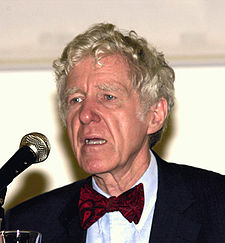 Some encouraging facts and figures are provided in an interview with the CEO of the European Wind Energy Association, Christian Kjaer, by Yale Environment 360. For the past two years 40 per cent of all new electricity generating capacity in Europe came from wind turbines. (Add solar and other renewables and that rises to 63 per cent.) From Spain to Sweden so many new turbines are being erected that Europe is on target to produce 15 per cent of its electricity from wind by 2020 and 50 per cent by 2050.
Some encouraging facts and figures are provided in an interview with the CEO of the European Wind Energy Association, Christian Kjaer, by Yale Environment 360. For the past two years 40 per cent of all new electricity generating capacity in Europe came from wind turbines. (Add solar and other renewables and that rises to 63 per cent.) From Spain to Sweden so many new turbines are being erected that Europe is on target to produce 15 per cent of its electricity from wind by 2020 and 50 per cent by 2050.
Kjaer puts the emergence of wind as Europe’s leading form of green energy down to a combination of government policies, entrepreneurial vision, and public support. Carrots and sticks are involved. The European Union provides tax credits, financial incentives, and priority access for renewable energy to the electricity grid to encourage the growth of wind, solar and other forms or renewables. The stick is the requirement that member states set renewable energy targets or face the possibility of being sued.
The result is that increasingly as plants fired by coal and natural gas reach the end of their lives they are being replaced by wind and solar power. The economic benefits of the transition are clear, with nearly 200,000 people currently employed in European wind power, rising to an estimated 450,000 by 2020. Kjaer has no doubt that green energy is an engine of job creation.
He thinks the early start that Europe gained in wind power, particularly in Spain and Germany and Denmark, gives them an advantage in the new industry and means they are reaping commercial benefits in terms of wind turbine manufacturing and activity further down the supply line. The high quality manufacturing sector, strongly supported by governments, should see Europe retaining an edge over the intensifying competition from Asian countries. “The winners of tomorrow’s energy wars,” he says, “are going to be those who understand how to develop new technology, deploy new technology and get the benefits of exporting that technology to the rest of the world.”
He speaks of the need for Europe to make a serious effort in terms of changing the way they operate their grids, and to move more quickly to develop an offshore grid for utilizing the offshore wind energy. Politicians need to give attention to optimizing and expanding the grid infrastructure to accommodate a larger amount of variable wind power in the system, and also other renewables.
“One of the main reasons for the strong political support for a supergrid is also that we want to create an internal [European] market for electricity, which of course, in the end, should give consumers the most affordable electricity. That’s the whole idea about the internal market, is that it would create the free movement over borders of goods, services, and in this case electricity at the lowest cost. And in order to create an internal market for electricity you need the infrastructure, just as you need roads to move goods around the European Union.”
Concerning policies required for a robust industry Kjaer speaks first of stable long-term frameworks for investing in renewables. Stable frameworks help the European industry by contrast with the US where the framework is unable to be predicted more than one or two years ahead. This means the US is not reaping the job creation benefits of wind energy; a lot of manufacturing has to be imported since no one’s going to invest in a factory in the United States if they don’t know how the market looks beyond the next two years.
As an aside, a news item today reported US steelworkers complaining that in the manufacture of wind turbines and solar panels China is breaking WTO rules by an array of subsidies, tax credits, cut-rate loans, and other policies that give Chinese companies a strong competitive advantage over foreign firms. If Kjaer is right they might do better to complain of their own government’s failure to support green energy development ahead of the fossil fuel industry which is still favoured by extensive subsidies.
To return to Europe. Kjaer identifies three elements in the stable framework Europe is providing for renewable energy. Financial support such as tax credit is one. Access to the grid is another:
“And what European legislation does, it mandated all 27 member states to give priority access to wind energy, which means that if you have a wind farm and a gas plant, and they’re planned projects, the wind energy should be connected first. And also, if you have plants operating on the system, electricity from the renewables plant gets fed into the grid first.”
The third element is more straightforward administrative procedures. Kjaer spoke of hopes of streamlining what in some European countries are extremely tortuous permission processes.
Asked about public opposition to the expansion of wind turbines, he acknowledged it was an issue, more so in some countries than others. Onshore turbines in the UK are particularly difficult.
“But it’s my feeling that the concern from locals is biggest in the beginning of a new market taking off. So the first thousand megawatts are much more difficult to install than the next thousand megawatts. Because people get used to them, they understand that they don’t make noise anymore — the turbines twenty years ago made quite a lot of noise, today you can’t hear them, almost, if you’re more than two hundred meters away.”
Asked whether 100 per cent renewable electricity by 2050 was possible Kjaer explained why he thinks it is:
“Almost two-thirds of our new capacity is from renewables. That figure was about 20 per cent in the year 2000. So in nine years we’ve gone from 20 per cent to 62 — by 2020 of course we can get to 100 per cent of new capacity. And if we can get in 2020 to a situation where all new capacity is renewables, then we will, by definition almost, have 100 per cent renewable electricity by 2050 because all the other power plants will be taken off [line].”
Infrastructure is the absolute key:
“ – we need to build an infrastructure that is different. But, again, our infrastructure in Europe is aging – we haven’t been building power lines since the ‘60s or ‘70s. It needs to be replaced anyway. So we need to make sure that the infrastructure is changed in a way that it accommodates 100 per cent renewable electricity by 2050.”
While I was preparing this post a newsletter coincidentally arrived from the New Zealand Wind Energy Association, welcoming the Government’s continued commitment to its target of 90 per cent renewable electricity by 2025 in the draft New Zealand Energy Strategy and affirming the part that wind generation is able to play.
“In New Zealand, wind generation has increased 10-fold since 2003, helping lift total renewable generation to recent highs of over 70%. With four wind farms currently under construction, together with other new and planned renewable projects, New Zealand is making progress towards the 90% target and the rewards that it brings to the economy and the environment.”
It points to the economic advantage of globally competitive electricity prices that will accrue to New Zealand in the development of its ample renewable energy resources.
“Electricity prices have increased significantly in recent years on the back of rising natural gas prices. Increasing use of renewables such as wind energy, which has no fuel or carbon emissions costs, is helping to check these rising prices.”
There’s a note of understandable exasperation in a section of the newsletter addressing the misinformation barrier which it says is bizarrely making it easier to obtain resource consent for new thermal generation than for renewable generation.
Such misinformation as this:
“In the last few months we’ve seen claims that a proposed wind farm won’t generate the amount of electricity that the developer estimates because wind generation varies with the wind. Such claims overlook that developers’ calculations already take the variable nature of wind generation into account. Developers usually identify both the installed generating capacity of the project in megawatts (or MW) and the total amount of electricity that they expect the project to generate in a year in gigawatt-hours (GWh). This estimate of generation takes into account the wind conditions at the site and that varying wind conditions affect generation.”
The newsletter points out that wind is proving itself in New Zealand on its own merits. (I would add, in spite of the unfair advantages enjoyed by fossil fuels which are only just beginning to have a modest price put on them.) Unlike other countries, New Zealand wind farms are not subsidised. A wind farm will be built here only when it can generate electricity at a cost that is competitive with other forms of generation.
The NZ wind resource is very strong by comparison with other parts of the world where wind farms are being installed. Our wind farms generate almost twice as much electricity per installed megawatt of capacity as the international average.
In response to the claim that new thermal generation is required as back up for new wind farms the newsletter responds that our existing hydro base is sufficient to balance about 2000MW of wind capacity without adding significantly to the price of electricity. Current wind energy capacity sits just under 500MW, so there’s obviously some distance to go before back up becomes a serious concern.
It’s the view of the newsletter that the considerable range of research and practical experience available regarding wind energy after more than 10 years operation in NZ and more than 20 years overseas reveals that many of the claims commonly heard in denigration of wind energy do not stand up to scrutiny.
So, this evidence from Europe and New Zealand, along with that from the US and from China among others, demonstrates that in spite of all its detractors wind generation is advancing rapidly. It’s heartening to see that there are governments prepared to offer the financial and policy support that it needs. Some point sneeringly to that and utter the dirty word ‘subsidies’. In a market place which doesn’t price the environmental costs of fossil fuels there is currently no other way of putting renewables on an equal footing. In any case the imperative to phase out emissions means that we must pay what it costs to do so, just as, for example, we are preparing to pay the costs of repairing the earthquake damage in Canterbury. There are some expenditures which can’t be avoided. Would that our Draft Energy Strategy would recognise that.
Like this:
Like Loading...

 As an example of contradictory thinking it would be hard to better Energy and Resources Minister Gerry Brownlee this week. He was announcing that oil and gas exploration in New Zealand is to get a substantial boost in government resources, including funding to further the possible exploitation of deep-sea methane hydrates.
As an example of contradictory thinking it would be hard to better Energy and Resources Minister Gerry Brownlee this week. He was announcing that oil and gas exploration in New Zealand is to get a substantial boost in government resources, including funding to further the possible exploitation of deep-sea methane hydrates. Some encouraging facts and figures are provided in an
Some encouraging facts and figures are provided in an  One of the things that persuaded Gwynne Dyer that it was time to write his book
One of the things that persuaded Gwynne Dyer that it was time to write his book